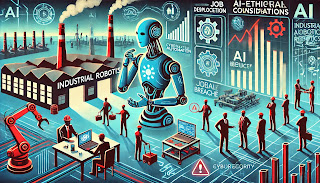AI-Powered Robotics in Industries: The Future of Automation.
The fusion of artificial
intelligence (AI) and robotics is transforming industries at an unprecedented
pace. From manufacturing floors to healthcare labs, AI-powered robots are
performing tasks with precision, adaptability, and efficiency that were once
unimaginable. But what exactly makes these robots so revolutionary? And how are
they reshaping the future of work?
In this article, we’ll explore
how AI enhances robotics, the industries benefiting the most, real-world
applications, and the challenges ahead. Whether you're a tech enthusiast or a
business leader, understanding this shift is crucial—because the future of
automation is already here.
How AI Supercharges Robotics?
Traditional robots follow pre-programmed instructions—they’re fast and precise but lack flexibility. Introduce AI, and suddenly robots can learn, adapt, and make decisions in real time. Here’s how:
1. Machine Learning
& Computer Vision
AI-powered robots use machine
learning (ML) to improve over time. For example, a robot in a factory can
analyze thousands of product images to detect defects more accurately than a
human eye.
Computer vision allows robots to
"see" and interpret their surroundings. Autonomous forklifts in
warehouses, like those used by Amazon, navigate crowded spaces without human
guidance by processing live visual data.
2. Natural Language
Processing (NLP)
Some robots now understand and
respond to voice commands. In hospitals, AI-driven robotic assistants like Moxi
(developed by Diligent Robotics) can fetch supplies, allowing nurses to focus
on patient care.
3. Predictive
Maintenance
AI analyzes sensor data from
robots to predict failures before they happen. According to McKinsey,
predictive maintenance reduces downtime by 30-50%, saving industries billions.
Industries Transformed by AI-Powered Robotics
1. Manufacturing
& Assembly Lines
The automotive industry has been
an early adopter. Tesla’s factories
use AI-driven robots that adjust their movements in real time to assemble cars
with micron-level precision.
Foxconn, a major electronics manufacturer, replaced 60,000 workers with AI robots in a single factory—boosting efficiency while cutting labor costs.
2. Healthcare &
Surgery
Robotic surgeons like the da Vinci System assist doctors in
performing minimally invasive surgeries with superhuman steadiness. AI enhances
these systems by analyzing past surgeries to suggest optimal techniques
3. Logistics &
Warehousing
Companies like Ocado
(a UK-based grocery retailer) use AI-powered robots to sort and pack orders at
lightning speed. Their automated warehouses process 3.5 million items per week
with near-zero errors.
4. Agriculture
AI-driven robots, such as John Deere’s autonomous tractors, use
computer vision to plant, fertilize, and harvest crops with pinpoint accuracy.
This reduces waste and increases yields—critical as global food demand rises.
5. Customer Service
& Retail
Robots like Pepper
(by SoftBank) interact with customers in stores, answering questions and even
detecting emotions to improve service.
Challenges & Ethical Considerations
While AI-powered robotics offer immense benefits, they also pose challenges:
·
Job
Displacement: The World Economic Forum predicts that by 2025, automation
will displace 85 million jobs—but also create 97 million new roles. Reskilling
workers is essential.
·
Security
Risks: AI systems can be hacked. A malicious attack on industrial robots
could cause physical damage.
·
Bias in
AI: If training data is flawed, robots may make biased decisions—especially
in hiring or law enforcement applications.
The Future: What’s Next?
The next wave of AI robotics includes:
·
Collaborative
Robots (Cobots): Designed to work safely alongside humans.
·
Swarm
Robotics: Multiple robots coordinating like a hive mind (useful in disaster
recovery).
·
Emotion
AI: Robots that understand human emotions for better interaction.
As Boston Dynamics’ CEO Robert
Playter says: "We’re moving from
robots that do repetitive tasks to robots that think, adapt, and
collaborate."
Conclusion
AI-powered robotics is no longer
science fiction—it’s a reality reshaping industries. From boosting productivity
to tackling dangerous tasks, these intelligent machines are here to stay.
However, businesses and policymakers must address ethical concerns and
workforce transitions to ensure this revolution benefits everyone.
The question isn’t if AI robotics
will dominate industries—it’s how soon we adapt. And for those who embrace it,
the future looks incredibly promising.
Would you like to dive deeper into any specific application? Let me know in the comments! (Just kidding—this isn’t a blog, but you get the idea.) 🚀




